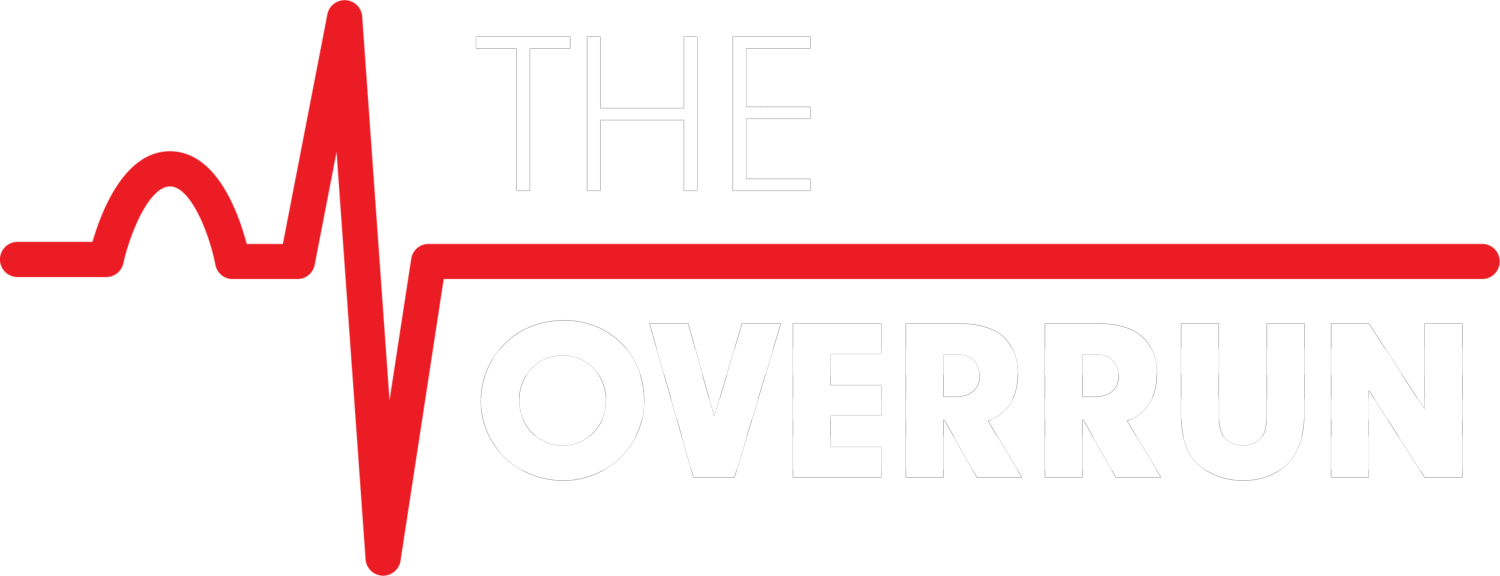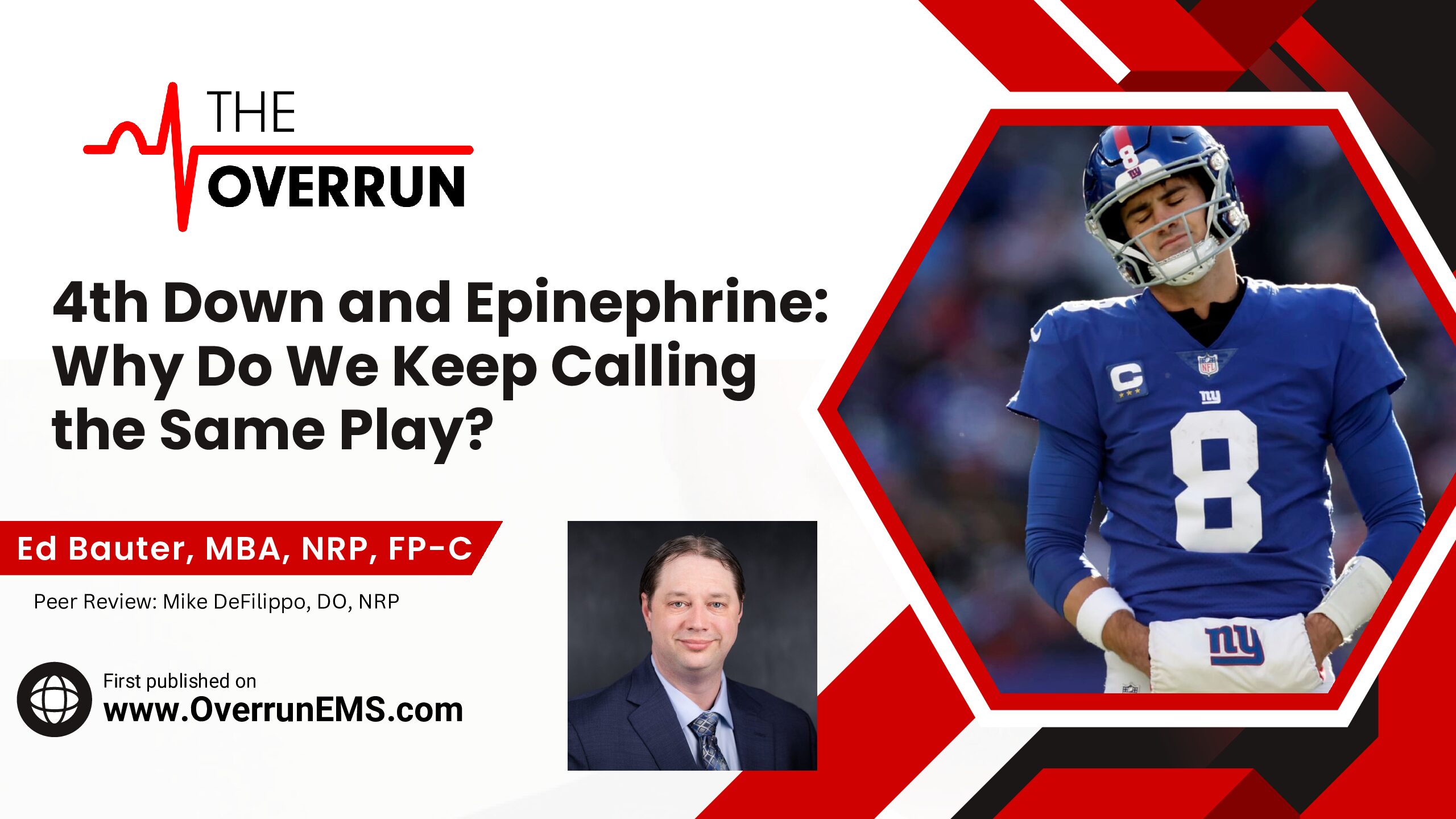As an Eagles fan in New Jersey, it’s easy to find ways to criticize the New York Giants. So, when I began drafting this post, I was elated to find a correlation between pre-hospital medicine, and a criticism of the Giants. What a world we live in. Anyway, here’s the big point.
Epinephrine in out-of-hospital cardiac arrest (OHCA) is like the Daniel Jones contract for the New York Giants.
After being drafted 6th overall out of known football powerhouse Duke University, Jones was projected to be the second coming for the Giants – a new Eli Manning for a new Big Blue Wrecking Crew generation. However, despite his high-profile contract worth $40 million per year, Jones has struggled to live up to expectations. His completion percentage currently ranks 18th among active quarterbacks, and he has passed for fewer than a thousand yards.
Much like Jones was expected to be the franchise savior, epinephrine was once hailed as a game-changer in cardiac arrest treatment. However, just as Jones has not delivered the results Giants fans hoped for, epinephrine has also failed to provide the long-term outcomes we desire in cardiac arrest. Despite early promise, both Jones and epinephrine remain controversial in their respective fields—one in football and the other in emergency medicine.

Now, this isn’t necessarily about Daniel Jones or the Giants (although writing that last part was fun for me), it is a statement about futility. To peruse social media today is to find dozens of posts about Daniel Jones and how it is time to move on and find another Quarterback.
Since at least 2012, studies have shown that while epinephrine improves the chances of ROSC, it does not improve long-term outcomes; a trend that has now continued for over a decade (1-5). Yet we continue to insist that epinephrine is the drug of choice for cardiac arrest, and “The Industry” continues to suggest that epinephrine will improve cardiac arrest, despite significant and continuing evidence to the contrary.
This blind adherence to protocol is not progressing EMS forward. Instead, we spend hours and days debating whether we’re giving the right dose (6), or if we should change the timing of the administration (7), or maybe we just give a placebo (which is equally effective) (8). We insist upon this drug as if it were our religion or perhaps our favorite sports team (Go Birds). It is becoming more and more clear that what we’re doing in the field for OHCA is simply ineffective. We should all focus on a new way forward.
How Did We Get Here?
In 2018, the PARAMEDIC2 trial was published in the New England Journal of Medicine to much fanfare from EMS providers. This study showed that epinephrine improved 30-day mortality over placebo, which was very exciting. We now had clinical data from human trials that showed an intervention that improved survival to discharge, but the question to the Profession was, what do we do with it? The PARAMEDIC2 trial included more than 8,000 patients, divided into two arms. One was to receive epinephrine, and the other was to receive a placebo. What was overlooked in this data (or at least what didn’t land with the intended audience) was that of these 8,014 patients that were included in the study, 7,785, or 97 percent of patients died before hospital discharge. A total of 54 patients, or less than 1 percent of the patients in this study, were discharged with a Rankin score of 0-1 (where 0 indicates no neurological damage and 6 indicates death) (8).
The administration of epinephrine in cardiac arrest has been the standard of care since the 1960s. In the lab, researchers evaluated canine models with asphyxia and recorded the results of epinephrine administration. Since this data was published, it has been recommended that epinephrine be given to all forms of cardiac arrest and codified in the AHA guidelines. This may be seen as a general advance in the practice, but in fact, this standard has made research into the efficacy of the drug very difficult. Researchers in Australia once attempted to complete a study comparing epinephrine to a placebo, but the researchers could not successfully recruit patients or programs, as 4 out of 5 programs were concerned about worsening patient outcomes and going against the standard of care (9). Despite this, we continue to produce research suggesting that vasopressors be used in OHCA, despite researchers stating that epinephrine and other vasopressors do not improve outcomes (2)(10) .
As you’re reading this, you may think that perhaps epinephrine would have a positive effect in the period after resuscitation. This would stand to reason, as a patient’s heart wasn’t working earlier, and now the provider would need to augment the patient’s blood pressure. This has been attempted, and still, we find no evidence of a benefit, regardless of using epinephrine or norepinephrine (11).
Given these variables, one may be concerned that perhaps timing or route of administration would be an issue. Surely, if we give epinephrine early enough, we can cause a positive change. Or perhaps the problem is venous access versus intraosseous access? Which route gets us closer to central circulation and gets the drug to the heart faster? Some available data suggests that increasing the space between epinephrine infusions may improve outcomes (12), however, there are also conflicting data suggesting that shortening the time interval improves outcomes (7).
So What Works?
This isn’t to suggest that using epinephrine in cardiac arrest is futile, but we must accept as providers that our current system is not working. Or at least it is not working the way it intended. We know that early CPR and early defibrillation improve outcomes, yet the chain of survival still fails to work if we cannot recruit laypeople to be willing to do CPR and use an AED ((13)(14). Given this, the obvious problem that EMS faces is one that we all face, which is time. EMS is a limited resource that is often dispatched from far distances to patients who do not have time to wait for us. This is an area of focus that emergency medicine and EMS need to focus on and work together to raise awareness.
What about airway management? We know that oxygen is the key component in cardiac arrest, but how important is the airway? Every paramedic who has walked on the scene of a cardiac arrest has felt that buzz so many feel when we have the opportunity to intubate. We have been coached since we entered EMS that an endotracheal tube (ETI) is the gold standard of airway management, and while that may be largely true, the data do not suggest that ETIs are superior to any other airway adjunct (15).
As it stands, the data simply do not support epinephrine improving neurologically intact survival. Patients experiencing medical cardiac arrests seem to benefit more from early CPR and early defibrillation performed by bystanders than they do from any advanced intervention (in fact, performing advanced procedures such as ETI may decrease preload and worsen outcomes). There may be future use for EMS providers to use ECMO or REBOA in cardiac arrest, and while the data on these are still slim, there is an issue with cost feasibility among EMS systems (16).
Conclusion
EMS, as an industry, has been relying on data that was published sixty years ago to guide our treatment. Despite the current and mounting evidence against the use of epinephrine in cardiac arrest, we insist on adhering to a dogma that does not benefit patients. While reading the data, there is never an “A-HA!” OR “EUREKA!” moment. We must take a step back as a profession and decide who we want to be and what services we want to provide our patients. In the face of decades of extant data that the use of epinephrine is largely futile, we must have the bravery to admit that perhaps we have been wrong this entire time. Without these changes, people will continue to not survive cardiac arrest, an illness that already claims 300,000 lives in the United States per year.
Daniel Jones has lost two games this season at the time of writing. After one loss, Giants fans were calling for Jones’ head and for his backup, New Jersey native Tommy DeVito (Tommy Cutlets), to take over as QB. My football fandom (and joy at Giants fan’s misery) put aside, in sports, we take the time to realize when something isn’t working, and we take action to fix it. We should start applying the same principles to medicine.

References:
1. Akihito Hagihara, Manabu Hasegawa, Takeru Abe, Takashi Nagata, Yoshifumi Wakata, Shogo Miyazaki. Prehospital Epinephrine Use and Survival Among Patients With Out-of-Hospital Cardiac Arrest. JAMA [Internet]. 2012 Mar 21;307(11):1161–8. Available from: https://jamanetwork.com/journals/jama/fullarticle/1105081
2. Kasha Bornstein, Brit Long, Alessandra Della Porta, Guy Weinberg. After a century, Epinpehrine’s role in cardiac arrest resuscitation remains controversial. Am J Emerg Med. 2020 Aug 21;39:168–72.
3. Florence Dumas, Wulfran Bougouin, Guillaume Geri, Lionel Lamhaut, Adrien Bougle, Fabrice Daviaud, et al. Is Epinephrine During Cardiac Arrest Associated With Worse Outcomes in Resuscitated Patients? J Am Coll Cardiol [Internet]. 2014 Dec 9;64(22):2360–7. Available from: https://www.sciencedirect.com/science/article/pii/S0735109714064791?via%3Dihub
4. Hannah Kempton, Ruan Vlok, Christopher Thang, Thomas Melhuish, Leigh White. Standard dose epinephrine versus placebo in out of hospital cardiac arrest: A systematic review and meta-analysis. Am J Emerg Med [Internet]. 2019 Mar;37(3):511–7. Available from: https://www.sciencedirect.com/science/article/abs/pii/S0735675718310337?via%3Dihub
5. K.T. Ng, W.Y. Teoh. The Effect of Prehospital Epinephrine in Out-of-Hospital Cardiac Arrest: A Systematic Review and Meta-Analysis. Prehospital Disaster Med [Internet]. 2019 Aug 28;34(5):532–9. Available from: https://www.cambridge.org/core/journals/prehospital-and-disaster-medicine/article/abs/effect-of-prehospital-epinephrine-in-outofhospital-cardiac-arrest-a-systematic-review-and-metaanalysis/4FAB28E75670399A2279DBCFEDDF0E3C
6. Zachary Boivin, MD, Kevin M. Duignan, MD, Donias Doko, MD, Nicholas Pugilese, PharmD, Trent She, MD. Epinephrine in Cardiac Arrest: Identifying A Potential Limit for Resuscitation. West J Emerg Med [Internet]. 2023 Nov;24(6). Available from: https://escholarship.org/uc/item/656854c1
7. Sam A. Warren, Ella Huszti, Steven M. Bradley, Paul S. Chan, Chris L. Bryson, Annette L. Fitzpatrick, et al. Adrenaline (epinephrine) dosing period and survival after in-hospital cardiac arrest: A retrospective review of prospectively collected data. Resuscitation [Internet]. 2014 Mar;85(3):350–8. Available from: https://www.sciencedirect.com/science/article/abs/pii/S0300957213007983
8. G.D. Perkins, C. JI, C.D. Deakin, T. Quinn, J.P. Nolan, C. Scomparin, et al. A Randomized Trial of Epinephrine in Out-of-Hospital Cardiac Arrest. NEJM [Internet]. 2018 Jul 18;379(8):711–21. Available from: https://www.nejm.org/doi/full/10.1056/NEJMoa1806842
9. Julianna Jung, Julie Rice, Sharon Bord. Rethinking the role of epinephrine in cardiac arrest: the PARAMEDIC2 trial. Ann Transl Med [Internet]. 2018 Dec 14;6(Suppl 2)(S129). Available from: https://www.ncbi.nlm.nih.gov/pmc/articles/PMC6330609/pdf/atm-06-S2-S129.pdf
10. Jasmeet Soar, et al. 2019 International Consensus on Cardiopulmonary Resuscitation and Emergency Cardiovascular Care Science With Treatment Recommendations: Summary From the Basic Life Support; Advanced Life Support; Pediatric Life Support; Neonatal Life Support; Education, Implementation, and Teams; and First Aid Task Forces. Circulation [Internet]. 2019 Nov 14;140(24). Available from: https://www.ahajournals.org/doi/10.1161/CIR.0000000000000734
11. Tanner Smida, Remle Crowe, P.S. Martin, James F. Scheidler, Bradley S. Price, James M. Bardes. A retrospective, multi-agency ‘target trial emulation’ for the comparison of post-resuscitation epinephrine to norepinephrine. Resuscitation [Internet]. 2024 May;198. Available from: https://www.resuscitationjournal.com/article/S0300-9572(24)00094-7/abstract
12. Nicholas Mohr, MD, MS, Bret Faine, PharmD, MS. Epinephrine in Out-of-Hospital Cardiac Arrest: What Is the Role of the Timing Interval? Ann Emergencuy Med [Internet]. 2019 Dec;74(6):807–8. Available from: https://www.annemergmed.com/article/S0196-0644(19)30477-9/abstract
13. Shijiao Yan, Yong Gan, Nan Jiang, Rixing Wang, Yungiang Chen, Zhiqian Luo, et al. The global survival rate among adult out-of-hospital cardiac arrest patients who received cardiopulmonary resuscitation: a systematic review and meta-analysis. Crit Care [Internet]. 2020 Feb 22;24(61). Available from: https://ccforum.biomedcentral.com/articles/10.1186/s13054-020-2773-2
14. Wanis H Ibrahim. Recent advances and controversies in adult cardiopulmonary resuscitation. Postgrad Med J [Internet]. 2007 Oct;83(984):649–54. Available from: https://www.ncbi.nlm.nih.gov/pmc/articles/PMC2600120/
15. Jing Lou, Sijia Tian, Xuqin Kang, Huixin Lian, Hongmei Liu, Wnzhong Zhang, et al. Airway management in out-of-hospital cardiac arrest: A systematic review and network meta-analysis. Am J Emerg Med [Internet]. 2023 Mar;65:130–8. Available from: https://www.sciencedirect.com/science/article/pii/S0735675722007719?casa_token=Qk9CPZVOVoIAAAAA:4ZluOoPtAgpHuHmyC4LArhOGnl5kN0Zox7N5ZnIVsvoS4srDRYwkoZGaU-PYiz3rr4n98XTOmkg
16. James E. Manning, Jonathan J. Morrison, Paul E. Pepe. Prehospital Resuscitation: What Should It Be? Adv Surg [Internet]. 2023 Sep;57(1):233–56. Available from: https://www.advancessurgery.com/article/S0065-3411(23)00008-8/abstract

